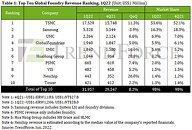Magnitude 7.4 Earthquake in Taiwan Halts Production at TSMC and Other Foundries
At 07:58 local time, Taiwan was rocked by a magnitude 7.4 earthquake on the east coast which was felt nationwide and as far as to the southeastern parts of China and southern Japan. It caused some major damage in the east coast city of Hualien where the epicentre of the quake was located, as well as surrounding areas. The earthquake reportedly left nine people dead and over 900 people injured islandwide. TSMC, UMC, PSMC and Innolux all halted some of their production lines in the Hsinchu Science Park on the west coast of the island, although this is said to have been as a preventive step, rather than caused by actual damage from the earthquake.
All the above-mentioned companies also evacuated their staff from their factories due to the intensity of the quake, as it reached a magnitude of around four or five almost island wide. The semiconductor manufacturers are all inspecting their fabs now to make sure none of the equipment was damaged by the earthquake. Innolux also has a factory in the southern city of Kaohsiung and has reported that it has suspended production in Hsinchu, but that production in Kaohsiung wasn't affected. Local media in Taiwan hasn't made any mention of the likes of Micron or other chip manufacturers, but it's likely that the situation is similar, since all of these companies are located in the same areas on the island. Aftershocks have continued throughout the day and there's a risk for further big earthquakes to follow in the coming days.Images courtesy of the Taiwan Central Weather Administration (CWA).
Update 15:11 UTC: Updated with an official statement from Micron below.
All the above-mentioned companies also evacuated their staff from their factories due to the intensity of the quake, as it reached a magnitude of around four or five almost island wide. The semiconductor manufacturers are all inspecting their fabs now to make sure none of the equipment was damaged by the earthquake. Innolux also has a factory in the southern city of Kaohsiung and has reported that it has suspended production in Hsinchu, but that production in Kaohsiung wasn't affected. Local media in Taiwan hasn't made any mention of the likes of Micron or other chip manufacturers, but it's likely that the situation is similar, since all of these companies are located in the same areas on the island. Aftershocks have continued throughout the day and there's a risk for further big earthquakes to follow in the coming days.Images courtesy of the Taiwan Central Weather Administration (CWA).
Update 15:11 UTC: Updated with an official statement from Micron below.
































